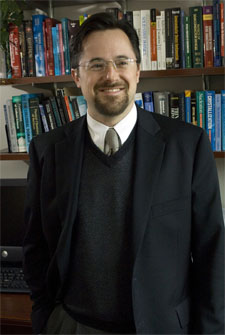
The sun may be setting on silicon. With a sunlight-to-electricity conversion efficiency of 15-20%, crystalline silicon modules are currently the most common type of solar cell. But silicon modules have an energy payback time — how long the module must collect sunlight to recover the amount of energy used to manufacture the module — of about 3 years. While some scientists are working diligently to improve silicon technology, Prof. Hugh Hillhouse is developing alternatives that may be extremely cheap to manufacture and have energy payback times of just a few months. The secret: nanocrystal and molecular inks. Hillhouse has been developing new nanomaterials and methods for solar energy conversion for over a decade. However, just recently they have begun to perfect solar cells created from inks composed of Earth abundant elements. Hillhouse and a team of UW collaborators will use a recent National Science Foundation grant to explore the fundamental science, develop the technology, and potential change the solar energy landscape.
Awarded a NSF Sustainable Energy Pathways grant in August, PI Hillhouse will work with UW faculty and researchers to determine if solar cells from earth abundant elements can be a sustainable, environmentally low-impact, and profitable form of electricity production. Formed from abundant minerals in the Earth’s upper crust, one compound Cu2ZnSnS4 (CZTS) appears to be a likely candidate for effective, sustainable solar energy conversion. “The laws of nature (quantum mechanics) just so happen to work out such that the electrons that are excited by sunlight in the material live for a long time,” said Hillhouse. “It gives us time to direct them out of the solar cell and into the electrical circuit — to run to a light, a motor, or a battery. Only a small number semiconductor materials satisfy that metric, but even then, many either do not form stable solar cell devices or are too expensive to purify and process. The icing on the cake is that we can make coatings of this CZTS material using simply made nanocrystal or molecular inks.”
Hillhouse’s team will conduct a rigorous life cycle assessment to reveal the true cost of producing the cells and any unintended environmental impacts that may come from their production and use. The outcomes of the assessment will direct molecular engineering efforts to develop new fabrication strategies and change the architecture of the device. The group also hopes to improve on the efficiency and decrease cost of production of the cells through front-buffer-layer and back-contact replacements.
“CZTS based devices have reached 11% efficiency already,” said Hillhouse. “If this can be increased to 20%, the economics to mass produce the devices could be stellar.”
Professors from across the campus will bring their knowledge to the project. Collaborators include Chemistry’s Daniel Gamelin and David Ginger, Evans School of Public Affairs’ Alison Cullen, Materials Science and Engineering’s Christine Luscombe, Physics’ Xiaodong Xu, Electrical Engineering’s Scott Dunham, and Environmental and Occupational Health Sciences’ David Eaton. “The NSF SEP team is truly multidisciplinary. The College of Engineering and College of Arts & Sciences faculty bring together expertise in molecular synthesis, quantum dots, material defect chemistry, ab initio calculations, graphene physics, spectroscopy, and scanning probe microscopy, all of which will combine to possibly forge a more efficient cell. In addition, Alison Cullen, an expert in risk and economics, and Dave Eaton, an expert in environmental toxicology, will both be key for us connecting the dots and making sure that cure isn’t worse than the disease.”
“This collaborative UW research effort, and the entire SEP initiative from the National Science Foundation, is important and novel in that we are really looking at a critical societal issue from a system level perspective. Yes, we will discover new phenomena and develop better solar cells, but we will also be looking at the impact and potentially unintended consequences of the technology,” Hillhouse said. “The new information we discover through the life-cycle analysis could completely change the course of the basic science effort.”
Deployment of experimental solar cell technology based on their design will take place at the new Solar Energy Testbed Facility located on the top of the UW power house. Real time performance data will be collected side-by-side with other solar cell technologies under real conditions.
The four-year grant, “Sustainable Pathway to Terawatt-Scale Solution-Processed Solar Cells from Earth Abundant Elements,” will receive $1.9M of funding beginning this fall.